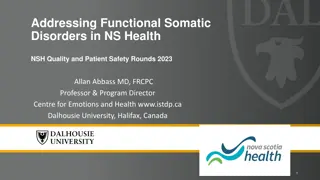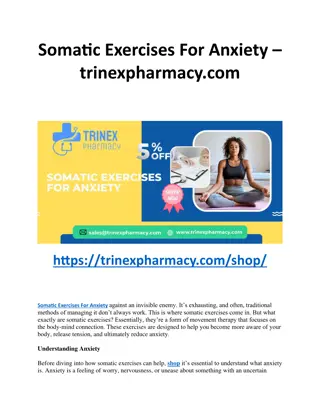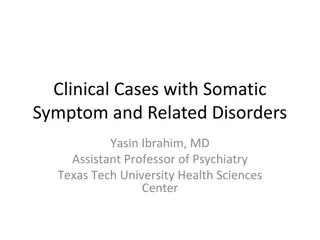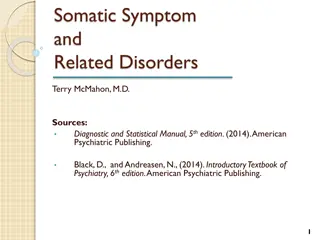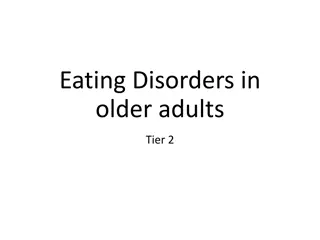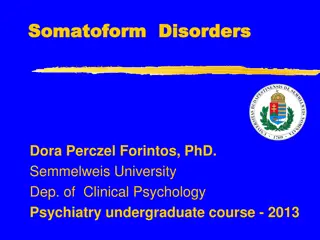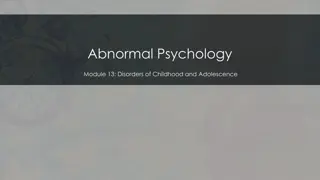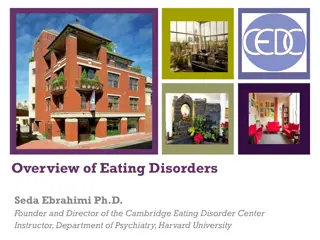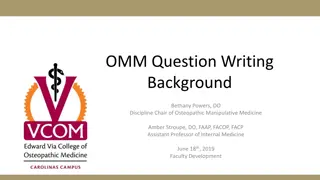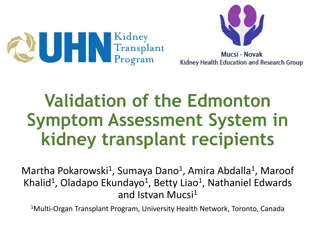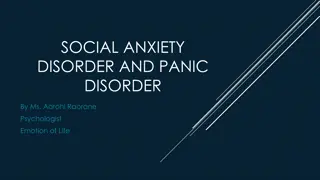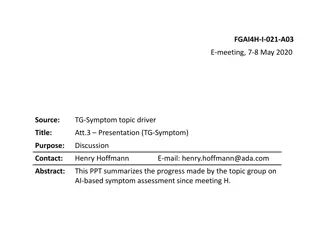Understanding Somatic Symptom Disorder and Related Disorders
This educational material delves into Somatic Symptom Disorder, Factitious Disorder, and Malingering, emphasizing the importance of accurate diagnosis and management. It explores various aspects, including symptoms, classifications, and implications in bridging physical and mental health. The content also highlights the significance of collaborative care between psychiatrists and other healthcare professionals.
Download Presentation

Please find below an Image/Link to download the presentation.
The content on the website is provided AS IS for your information and personal use only. It may not be sold, licensed, or shared on other websites without obtaining consent from the author. Download presentation by click this link. If you encounter any issues during the download, it is possible that the publisher has removed the file from their server.
E N D
Presentation Transcript
Somatic Symptom Disorder, Factitious Disorder and Malingering APM Resident Education Curriculum Thomas W. Heinrich, M.D. Associate Professor of Psychiatry & Family Medicine, Chief, Psychiatric Consult Service at Froedtert Hospital Department of Psychiatry & Behavioral Medicine, Medical College of Wisconsin Edited and Updated: Thomas Soeprono, M. D. Assistant Professor of Psychiatry, University of Washington Version of March 15, 2019 ACADEMY OF CONSULTATION-LIAISON PSYCHIATRY Psychiatrists Providing Collaborative Care Bridging Physical and Mental Health
Outline Somatic Symptom Disorder (300.82) Other Specified Somatic Symptom and Related Disorder (300.89) Unspecified Somatic Symptom and Related Disorder (300.82) Conversion Disorder (300.11) Illness Anxiety Disorder (300.7) Factitious Disorder (300.19) Psychological Factors Affecting Other Medical Conditions (316) Academy of Consultation-Liaison Psychiatry 2
Disclaimer Much of the data provided in this lecture is based on equivalent diagnosis from DSM- IV TR Most data is applicable and time will tell if significant shifts in data occur based on diagnosis changes (expect very mild changes if any) Academy of Consultation-Liaison Psychiatry 3
Somatic Symptom and Related Disorders Somatic Symptom Disorder Physical symptoms that prompt the sufferer to seek health care but remain unexplained after an appropriate evaluation (Richardson and Engel, 2004) Specify: With predominant pain Persistent Current severity: Mild, Moderate, Severe Academy of Consultation-Liaison Psychiatry 4
Somatic Symptom and Related Disorders Somatic Symptom Disorder One syndrome or many? Some authors have suggested that the precise diagnosis given depends more on the diagnosing physician s specialty than on any actual differences between the syndromes Categorization Psychiatric derived from primary psychiatric etiology (i.e. an anxiety disorder) Hypothetical syndromes based on diagnostic criteria Social derived from past trauma, exposure, or cultural differences in expression Academy of Consultation-Liaison Psychiatry 5
Somatic Symptom and Related Disorders Somatic Symptom Disorder One syndrome or many? Internal Medicine Chronic fatigue Gynecology Chronic pelvic pain ENT Idiopathic tinnitus Dentistry Temporomandibular dysfunction Rheumatology Fibromyalgia GI Irritable bowel syndrome Neurology Nonepileptic seizures Academy of Consultation-Liaison Psychiatry 6
Somatic Symptom and Related Disorders Somatic Symptom Disorder Consequences Impaired physician-patient relationship Physician frustration 1/6 primary care visits are considered difficult Hahn, 2001 Dose-response relationship between symptoms and physician frustration 0-1 symptom 6% difficult 2-5 symptoms 13% difficult 6-9 symptoms 23% difficult 10 or more symptoms 36% difficult Patient dissatisfaction Academy of Consultation-Liaison Psychiatry 7
Somatic Symptom and Related Disorders Somatic Symptom Disorder Consequences Psychosocial distress Decreased quality of life Increased rates of depression and anxiety Increased health care utilization Increased utilization leads to more harm Patient dissatisfaction Higher medical costs Provider burnout Academy of Consultation-Liaison Psychiatry 8
DSM-5 _________________________________________________________________ Why Change? Over-emphasis on medically unexplained symptoms (MUS) Shift from dx of exclusion to neurologic exam and positive symptom criteria Elimination of pejorative labels More functional approach Mind-body dualism Not used by clinicians Criteria were too sensitive and too specific Emphasis on disproportionate thoughts, feelings, and behaviors that accompany and are related to physical symptoms Academy of Consultation-Liaison Psychiatry
Old Diagnoses; New Addresses Moved to the obsessive compulsive and related disorders Body Dysmorphic Disorder Factitious Disorder Now included with the other Somatic Symptom Disorders Psychological factors affecting medical condition Academy of Consultation-Liaison Psychiatry
All That is Old is New Again _______________________________________ The New Diagnoses Somatization Disorder ________________ Undifferentiated Somatoform Disorder __________________ Pain Disorder Somatic Symptom Disorder With somatic symptoms Illness Anxiety Disorder Hypochondriasis Without somatic symptoms Academy of Consultation-Liaison Psychiatry
All That is Old is New Again _______________________________________ The Kinda-New Diagnosis Conversion (Functional Neurological Symptoms Disorder) Conversion Disorder Academy of Consultation-Liaison Psychiatry
DSM IV DSM 5 Somatization disorder Somatic Symptom Disorder Conversion disorder Conversion Disorder Same but shift in focus to positive signs and neuro exam Pain disorder Somatic Symptom Disorder with predominant pain also consider: Psychological Factors affecting Other Medical Conditions VS Adjustment Disorder Hypochondriasis Illness Anxiety Disorder Body Dysmorphic disorder moved to Obsessive-Compulsive and Related disorders Undifferentiated somatoform disorder Other Specified Somatic Symptom and Related Disorder Somatoform disorder NOS Unspecified Somatic Symptom and Related Disorder Academy of Consultation-Liaison Psychiatry 13
Somatic Symptom Disorder Generalities Presence of physical symptoms that suggest a general medical condition, but are not explained by a medical condition. Psychosocial stress = somatic distress Misinterpretation of normal physiological functions Not consciously produced or feigned Alexithymia Specify: With predominant pain Persistent Current severity: Mild, Moderate, Severe Academy of Consultation-Liaison Psychiatry 14
Somatic Symptom Disorder Alexithymia Term coined by Sifneos in 1973 Individuals who have difficulties expressing emotions verbally Correlates positively with: Depression Somatization Hypochondriasis Academy of Consultation-Liaison Psychiatry 15
Somatic Symptom Disorder DSM-5 Criteria 1+ somatic symptoms that are distressing or result in significant disruption of daily life Excessive thoughts, feelings, or behaviors related to the somatic symptoms or associated health concerns as manifested by at least 1 of the following: Disproportionate and persistent thoughts about the seriousness of one s symptoms Persistently high level of anxiety about health or symptoms Excessive time and energy devoted to these symptoms or health concerns Typically > 6 months Academy of Consultation-Liaison Psychiatry 16
Somatic Symptom Disorder Epidemiology (based on DSM-IV diagnosis for Somatization Disorder) Somatization disorder General population: 0.01% Primary care setting: 3% Subsyndromal somatization disorder General population: 11% Primary care setting: 20% Academy of Consultation-Liaison Psychiatry 17
Somatic Symptom Disorder Etiologies Defense mechanisms symptoms gaurd pt from experiencing thoughts/feelings Genetic & family studies Behavioral trained patterns of action that manifest throughout a pt s development Early life experiences ex: trauma Personality circumstances in development can manifest in particular patterns of coping and interrelatedness Academy of Consultation-Liaison Psychiatry 18
Somatic Symptom Disorder Differential diagnosis Medical conditions Disorders with transient nonspecific symptoms Psychiatric conditions Other somatoform disorders Depression Anxiety Varies by symptom Ex: Chronic fatigue vs hypothyroidism Ex: Irritable bowel syndrome vs allergy Ex: Nonepileptic seizures vs epileptic seizures Academy of Consultation-Liaison Psychiatry 19
Somatic Symptom Disorder Clinical features Large number of outpatient visits Frequent hospitalizations Repetitive subspecialty referrals Large number of diagnoses Multiple medications Multiple allergies Academy of Consultation-Liaison Psychiatry 20
Somatic Symptom Disorder Differential diagnosis (continued) The three features that most suggest a diagnosis of somatic symptom disorder instead of another medical disorder are Involvement of multiple organ systems Early onset and chronic course without development of physical signs or structural abnormalities Absence of laboratory abnormalities that are characteristic of the suggested medical condition Academy of Consultation-Liaison Psychiatry 21
Somatic Symptom Disorder Differential diagnosis Psychologization may not entirely explain somatic symptoms either Many patients have no other psychiatric diagnosis Directionality is unclear Even when physical symptoms respond to psychological treatments the effect size may be less than for depression Academy of Consultation-Liaison Psychiatry 22
Somatic Symptom Disorder General treatment issues: Schedule regular follow-up visits Perform a brief physical exam focused on the area of discomfort on each visit Look closely for objective signs of disease rather than taking the patient s symptoms at face value Avoid unnecessary tests, invasive treatments, referrals and hospitalizations. Avoid insulting explanations such as the symptoms are all in your head Explain that stress can cause physical symptoms Set limits on contacts outside of scheduled visits Academy of Consultation-Liaison Psychiatry 23
Somatic Symptom Disorder General treatment issues: Is diagnostic testing therapeutic? Noncardiac chest pain (Sox 1981) ECG vs. no test More satisfied and less disabled at 3-weeks, but no difference at 4-month follow-up Headache (Howard 2005) Ct scan of brain Less worried at 3 month, but not at 1 year So Limit work-ups to objective findings Academy of Consultation-Liaison Psychiatry 24
Somatic Symptom Disorder Specific treatments Psychotherapy Not responsive to long-term insight oriented psychotherapy Short-term dynamic therapy has shown some efficacy Cognitive-behavioral therapy has been shown to be effective Academy of Consultation-Liaison Psychiatry 25
Somatic Symptom Disorder Specific treatments Psychopharmacology Antidepressants have shown inconsistent results Antidepressants have limitations in treating Partial response instead of remission Higher discontinuation rates Sensitive to side effects nocebo Attribution to physical, whereas antidepressants suggest psychiatric risk of invalidation Unknown long-term efficacy Academy of Consultation-Liaison Psychiatry 26
Somatic Symptom Disorder Nonspecific treatments Reassurance Concluding the visit in a positive and reassuring manner has shown benefit (Kathol, 1997) Reassure regarding fears of abandonment Reattribution Broadening the agenda to include both physical and psychological factors may be beneficial (Fink 2002) Normalization Stating that one s test are normal or everything is fine has not been effective Need to address the patients concern(s) (Knipschild, 2005) Reassure ongoing efforts to address concerns Academy of Consultation-Liaison Psychiatry 27
Conversion Disorder Definition One or more symptoms involving voluntary motor or sensory function that suggest a medical condition Psychological factors are judged to be associated with the symptom Not intentionally produced or feigned Academy of Consultation-Liaison Psychiatry 28
Conversion (Functional Neurological Symptoms Disorder) One or more symptoms of altered voluntary motor or sensory function. Clinical findings provide evidence of a mismatch between the symptom and recognized neurological conditions. The symptom or deficit is not better explained by another medical or mental disorder. The symptom or deficit causes clinically significant distress or impairment in functioning or warrants medical evaluation. Academy of Consultation-Liaison Psychiatry 29
Conversion Disorder The theoretical goal of a conversion symptom Symbolic resolution of an unconscious conflict in an attempt to keep the conflicting memories out of consciousness Academy of Consultation-Liaison Psychiatry 30
Conversion Disorder Clinical subtypes (specify) With weakness or paralysis With abnormal movement With swallowing symptoms With speech symptom With attacks or seizures With anesthesia or sensory loss With special sensory symptom With mixed symptoms Academy of Consultation-Liaison Psychiatry 31
Conversion Disorder Specify timing: Acute episode (<6 months) Persistent (>6 months) Specify Stressor With psychological stressor Without psychological stressor Academy of Consultation-Liaison Psychiatry 32
Conversion Disorder Clinical features Symptoms likely to occur following stress Symptoms tend to conform to patients understanding of neurology Inconsistent physical exam Academy of Consultation-Liaison Psychiatry 33
Conversion Disorder Concern of misdiagnosis Slater (1965) reported a misdiagnosis rate of 33% The article warned that the diagnosis of hysteria was nothing more than a delusion and a snare. Stone et al (2005) reported a significant decline in misdiagnosis from the 1950s to the present day 1950 s 29%, 1960 s 17%, 1970-90 s 4% Authors felt that this decline was likely due to improvements in study quality, rather than improvements in diagnostic modalities Academy of Consultation-Liaison Psychiatry 34
Conversion Disorder Functional Neuroimaging Hysterical paralysis Decreased activity in frontal and subcortical circuits involved in motor control Hysterical anesthesia Decreased activity in somatosensory cortices Hysterical blindness Decreased activity in visual cortex Some studies have shown increased activity in limbic regions Academy of Consultation-Liaison Psychiatry 35
Conversion Disorder Treatment General/conservative Reassurance Addressing stressors Protective environment Appropriate workup has been done and full recovery is expected Physical and occupation therapy Psychotherapies Amytal interview Hypnosis Academy of Consultation-Liaison Psychiatry 36
Conversion Disorder Prognosis Good prognosis Onset following a clear stressor Prompt treatment Symptoms or paralysis, aphonia and blindness Poor prognosis Delayed treatment Symptoms of seizures or tremor Academy of Consultation-Liaison Psychiatry 37
Somatic Symptom Disorder with Predominant Pain Definition Pain is the predominant focus of clinical attention Complaints of pain are significantly affected by psychological factors Psychological factors are required in the Genesis of the pain Severity of the pain Maintenance of the pain Academy of Consultation-Liaison Psychiatry 38
Somatic Symptom Disorder with Predominant Pain Clinical features Pain may take various forms Pain is severe and constant Pain may be disproportionate to underlying condition Psychological factors predominate Pain is often the main focus of the patient s life There are concerns about the diagnostic validity of this somatoform disorder Academy of Consultation-Liaison Psychiatry 39
Somatic Symptom Disorder with Predominant Pain Differential Diagnosis Purely physical pain Adjustment disorder Depression Other somatoform disorders Substance use disorders Malingering Factitious disorder Academy of Consultation-Liaison Psychiatry 40
Somatic Symptom Disorder with Predominant Pain Treatment General Stress an understanding that the pain is real Goal is likely an improvement in functioning rather than a complete relief of pain Cognitive-behavioral therapy Relaxation therapy Biofeedback Hypnosis Pharmacotherapy Academy of Consultation-Liaison Psychiatry 41
Somatic Symptom Disorder with Predominant Pain Prognosis Poor prognosis Pre-existing character pathology Pending litigation Use of addictive substances Prolonged history of pain complaints Good prognosis Resolution of litigation Prompt treatment Academy of Consultation-Liaison Psychiatry 42
Illness Anxiety Disorder Definition Preoccupation with fears of having a serious illness that does not respond to reassurance after appropriate medical work-up. Epidemiology General population: ?? Medical clinic population: 4-6% Medical students: 3% Academy of Consultation-Liaison Psychiatry 43
Illness Anxiety Disorder Criteria Preoccupation with having or acquiring a serious illness. Somatic symptoms are not present or, if present, are only mild in intensity. If another medical condition is present or there is a high risk for developing a medical condition the preoccupation is excessive. There is a high level of anxiety about health. The individual performs excessive health-related behaviors or exhibits maladaptive health- related avoidance. Illness preoccupation has been present for >6 months, but the specific illness that is feared may change. The illness-related preoccupation is not better explained by another mental disorder. Academy of Consultation-Liaison Psychiatry 44
Illness Anxiety Disorder Clinical features Bodily preoccupation Disease phobia Disease conviction Onset in early adulthood Chronic with waxing and waning of symptoms Academy of Consultation-Liaison Psychiatry 45
Illness Anxiety Disorder Etiologies Psychodynamic model Symptoms can be seen as a defense against guilt Cognitive-behavioral model Misinterpretation of harmless bodily symptoms Better safe than sorry Physiologic model Low thresholds for, and low tolerance of, physical symptoms Academy of Consultation-Liaison Psychiatry 46
Illness Anxiety Disorder Treatment General aspects Establishment of trust History taking Identification of stressors Education Cognitive-behavioral therapy Supportive therapy Pharmacotherapy Serotonergic meds appear to most beneficial Academy of Consultation-Liaison Psychiatry 47
Factitious Disorder Definition Intentionally exaggerates or induces signs and symptoms of illness. Motivation is to assume the sick role Other incentives for the illness inducing behavior are absent Criteria Falsification of physical or psychological signs or symptoms Induction of injury or disease Presents self as ill, impaired, or injured Deceptive behavior in the absence of external rewards Not better explained by a mental disorder Academy of Consultation-Liaison Psychiatry 48
Factitious Disorder Specify Source Imposed on Self Imposed on Another (the perpetrator, not the victim, receives the dx) Specify Course Single Episode Recurrent Episodes (2+ events) Academy of Consultation-Liaison Psychiatry 49
Factitious Disorder Epidemiology Prevalence in general population is unknown Diagnosed in about 1% of patients seen in psychiatric consultation in general hospitals Likely higher in referral centers Academy of Consultation-Liaison Psychiatry 50


